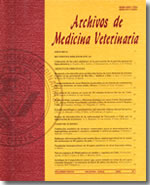Effect of naltrexone on the secretion pattern of the luteinizing hormone in prepubertal ewes
Main Article Content
Abstract
Secretion of LH is inhibited by opioid peptides during the prepubertal period in ewe lambs. The chronic blockade of opioid receptors with a long acting opioid receptor antagonist might accelerate the increase of LH secretion observed before the initiation of puberty. The objective of the present study was to explore the effect of naltrexone –a long acting opioid receptor antagonist– on the 24 h pattern of LH secretion and on the pulsatile LH secretion after 3 days of treatment. Ewe lambs (4 months old, 21 ± 1 kg, n=5) were given 1.5 mg naltrexone/kg body weight every 12 h for 3 days with a total of 7 doses. Pattern of LH secretion was assessed in plasma samples obtained at hourly intervals for 24 h which were analyzed with the COSINOR program; and with plasma samples obtained at 15 min intervals for six hours, which were analyzed with the PULSAR program before naltrexone treatment and before the treatment ended. Naltrexone did not modify the 24 h rhythm of LH secretion. On the other hand, the LH pulse frequency diminished from 7.8 ± 0.5 to 4.8 ± 0.4 pulses/6 h (p < 0.05). The mean pulse amplitude decreased from 0.83 ± 0.1 to 0.44 ± 0.07 (p < 0.05). Results suggest that naltrexone may be acting as an opioid agonist instead of antagonist in immature ewes.

